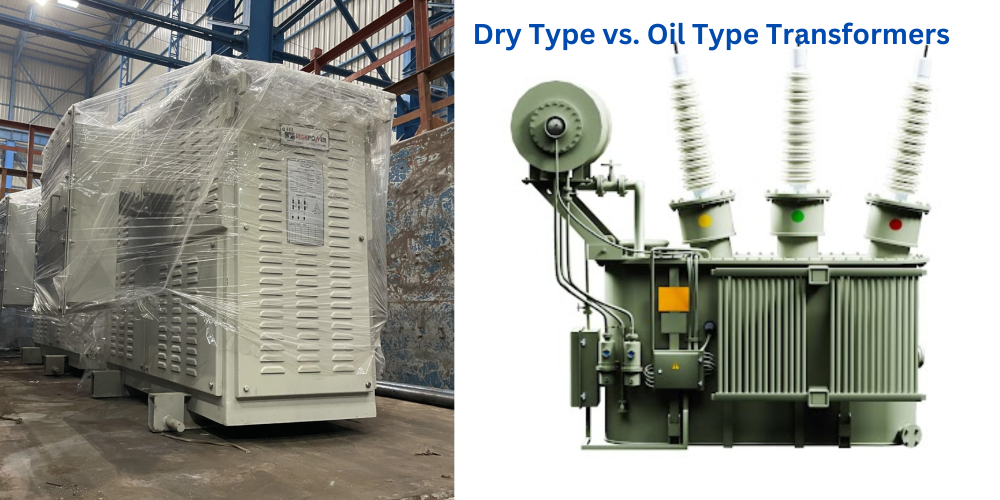Dry Type vs. Oil Type Transformers: A Comprehensive Comparison

Difference between Dry type transformer and Oil type transformer
For writing a blog, a transformer may not be a glamorous topic, but it plays a significant role in distributing energy. Whether it's in an industrial setting, commercial sector or residential buildings, the smooth flow of electricity is quietly ensured by a transformer. However, when choosing between dry-type and oil-type transformers, things can get confusing.
Thus, in this blog, we will be doing a comprehensive comparison of dry-type and oil-type transformers to help you make an effective decision.
What are Dry-type transformers?
A dry-type transformer is a stationary apparatus employing eco-friendly insulation systems for temperature regulation. It is alternatively referred to as a "cast resin-type transformer."
The transformers are kept within a case that has sufficient ventilation. It helps the coils to be cooled by circulating external air inside. Furthermore, these transformers contain windings made of varnished copper or aluminium. Due to its cooling limitations, the maximum voltage capacity for this transform is capped at 35kV.
What are Oil-type transformers?
Oil-filled or oil-type transformers are devices engineered for voltage conversions. The basic theory behind this type of transformer is it uses oil for its cooling properties. These transformers are housed within a welded steel tank filled with oil.
An oil-immersed transformer's coil and iron core generate heat, which is first absorbed by the insulating oil and then released into the cooling fluid during operation. The main use for oil-filled transformers is outdoors due to the oil's non-flammable characteristics.
Key differences between Dry type and Oil type transformers
-
Appearance
Both of the transformers have a different appearance. Dry-type transformers have different packaging. You can see the core and coil of the transformer directly, while oil-type transformers only show the outer shell.
-
Different Forms of Lead
Most oil-type transformers use porcelain bushings, whereas the dry-type transformers use silicone rubber bushings.
-
Different voltage and capacity
Dry-type transformers are suitable for most power distribution. The majority of them have a capacity below 1600 KVA and voltages under 10K. Some can reach 35KV. Oil-type transformers, however, can reach their full capacity from small to large. They also can achieve all voltage levels. Oil-type transformers are required for the UHV 1000KV testing line that is currently being built in our country.
-
Different insulation and heat dissipation
Dry-type transformers are usually insulated with resin and cooled using natural air. Oil-filled transformers, on the other hand, are insulated with insulating oils. The heat produced by the coil is transferred to the radiator fins of the transformer through the circulation of insulating oils inside the transformer.
-
Different applications
Dry-type transformers can be used for places where anti-fire or anti-explosion is required. They are generally easy to install in high-rise and large buildings. After an accident, oil-type transformers can spray or leak and cause fires. The majority of them are installed outdoors. It is possible to dig for oil in certain places safely.
-
Different load-bearing capacity
Dry-type transformers are usually operated under a fixed rated capacitance, whereas oil-type transformers are better able to handle overload than dry-type transformers.
-
Cost Differential
The price of dry-type transformers is higher than the price of oil-filled transformers for the same capacity. Dry-type transformers are generally classified as SC (epoxy resin cast encapsulation), SCR (non-epoxy solid insulation casting encapsulation), and SG open.
Oil-type transformers use mostly porcelain bushings, while dry-type transformers use mostly silicone rubber bushings.
Conclusion
Which transformer is right for your needs? However, it depends on the type of application, budget and environmental considerations. If you prefer safety, simplicity, and low maintenance cost, then you should go for a dry-type transformer.
Whereas, if you require high efficiency and cooling performance for demanding applications, an oil-type transformer might be the better choice.
Makpowerts can be your one-stop choice for choosing a dry-type or an oil-type transformer. Visit their site now!
- Industry
- Art
- Causes
- Crafts
- Dance
- Drinks
- Film
- Fitness
- Food
- Games
- Gardening
- Health
- Home
- Literature
- Music
- Networking
- Other
- Party
- Religion
- Shopping
- Sports
- Theater
- Wellness
- News


